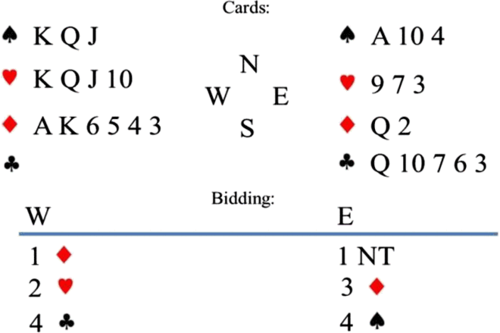June 17, 2014 report
Physicists propose way to use quantum bidding in bridge

(Phys.org) —A team of physicists in Europe, led by Marcin Pawlowski, has proposed a way to use entangled quantum particles to improve the odds of winning in the game of bridge. As the team notes in their paper published in Physical Review X, their proposition appears to be the first example of using quantum enhancement of information transfer as it applies to a real-world (non-physics) application.
Entanglement is where pairs of quantum particles are generated where their quantum state is no longer defined independently—instead a quantum state comes to exist that defines them as a single unit. The team in Europe has taken this concept and applied it to the game of bridge, increasing the odds of winning by a pair of players that successfully employs the strategy they've devised.
Bridge is a card game played by teams of paired individuals—successful players learn to communicate meaningfully with one another to convey information each needs to improve their hand, without being specific—that's against the rules. In this new scenario, Pawlowski, et al, suggest that in addition to a handful of cards, players are given the means to receive (and measure) one particle of an entangled pair from their mate—doing so they note, would not violate the rules of bridge as quantum entanglement cannot be used to send messages.
Use of entanglement in bridge would only come up during certain parts of play, such as when hands are dealt, and players on a team are trying to determine what cards their partner has that could be used to fill in the gaps in their own hand. Here team members would use combined measurements on the entangled particles along with information provided via coded bids to come up with partial information to help them better understand each other's cards. Such a strategy isn't foolproof, of course, it would help up the odds of winning rather than provide a clear path to victory. Pawlowski and his team have calculated that using their strategy would increase the probability of one team member guessing what cards their mate is holding from 87.5% to 89.5%, a 2 percent gain, but one that could for a team playing tournament style, mean a decided advantage.
More information: Quantum Bidding in Bridge, Phys. Rev. X 4, 021047 – Published 12 June 2014. journals.aps.org/prx/abstract/ … 03/PhysRevX.4.021047
ABSTRACT
Quantum methods allow us to reduce communication complexity of some computational tasks, with several separated partners, beyond classical constraints. Nevertheless, experimental demonstrations of this have thus far been limited to some abstract problems, far away from real-life tasks. We show here, and demonstrate experimentally, that the power of reduction of communication complexity can be harnessed to gain an advantage in a famous, immensely popular, card game—bridge. The essence of a winning strategy in bridge is efficient communication between the partners. The rules of the game allow only a specific form of communication, of very low complexity (effectively, one has strong limitations on the number of exchanged bits). Surprisingly, our quantum technique does not violate the existing rules of the game (as there is no increase in information flow). We show that our quantum bridge auction corresponds to a biased nonlocal Clauser-Horne-Shimony-Holt game, which is equivalent to a 2→1 quantum random access code. Thus, our experiment is also a realization of such protocols. However, this correspondence is not complete, which enables the bridge players to have efficient strategies regardless of the quality of their detectors.
Journal information: Physical Review X
© 2014 Phys.org




















